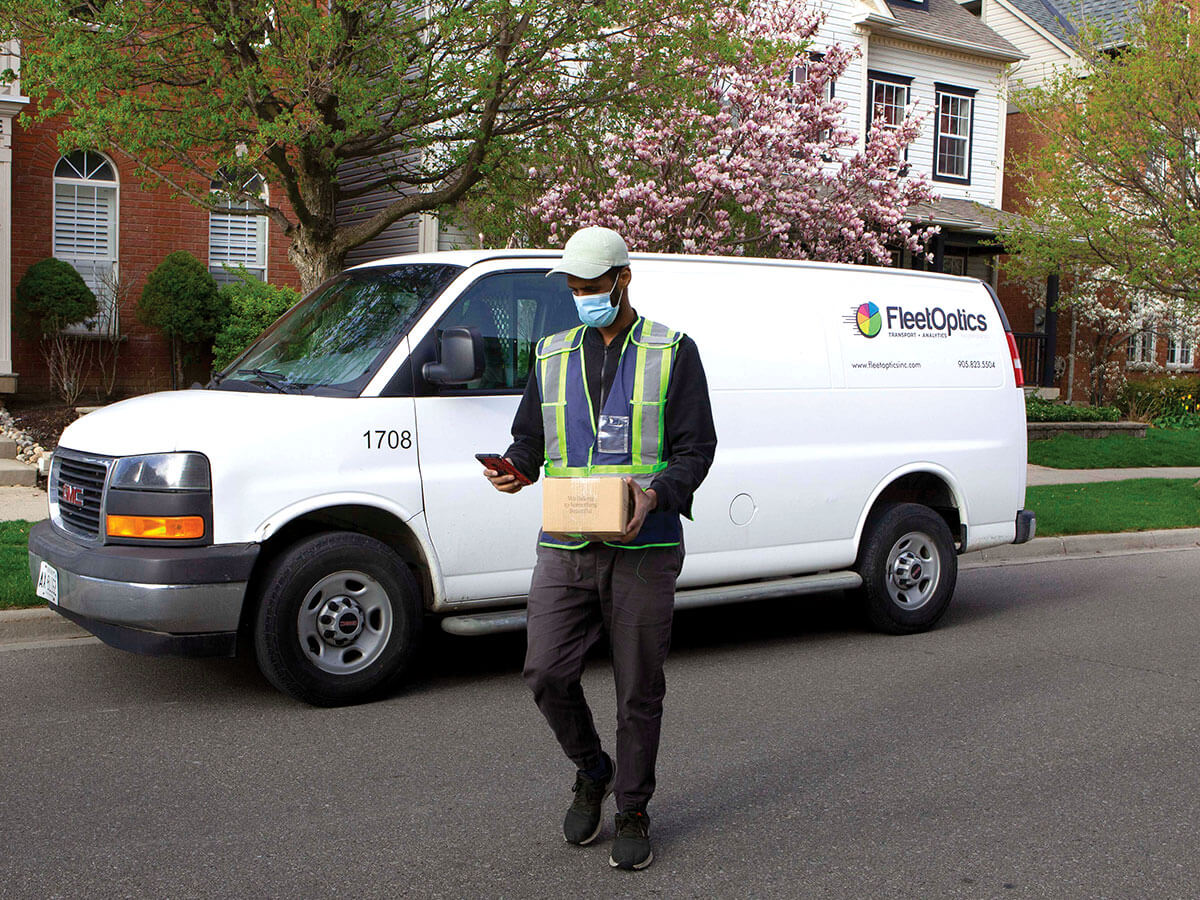
FleetOptics: e-commerce’s secret weapon
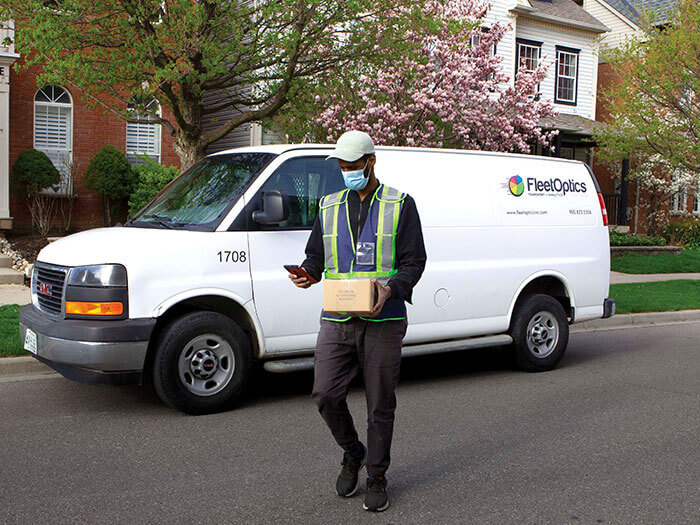 FleetOptics’ app tracks the exact location of every shipment and offers an estimate of when the item will be delivered (Photograph by Aaron Wynia)
FleetOptics’ app tracks the exact location of every shipment and offers an estimate of when the item will be delivered (Photograph by Aaron Wynia)
In March 2020, as the threat of COVID-19 escalated, cities around the world turned into ghost towns. With lockdowns in place, we huddled at home, reduced to blinking dots on a Google map, separated not just from each other, but from essential commodities. For some, these consumer-based challenges weren’t just a matter of convenience, but of life and death—if you were elderly or immunocompromised, your distance from the pharmacy could keep you from necessary medication and supplies.
As those days stretched into months, even as traffic in general slowed to a trickle, a certain kind of vehicle became a familiar sight on streets throughout Toronto, Montreal and Vancouver: a white cube van, cheery rainbow pie chart emblazoned on its side, occupying a curbside spot for the duration of a quick dash between the driver’s seat and a nearby front door. They ferried mascara, textbooks, antihistamines, coffee makers. These unassuming vans were the fastest connection between store and customer, the solution to the problem of how to get everyday essentials from their points of origin to the people who needed them most. They were the connective tissue between all those blinking dots on Google maps, a lifeline during a once-in-a-lifetime crisis.
The company behind those vehicles is FleetOptics, which bills itself as the Uber of parcel delivery. Over the past six years, FleetOptics has built up its reputation by mastering what’s known as “final-mile” logistics—in essence, the business of figuring out how to get purchases from retail depots into customers’ eager hands. At a time when online shopping is not just an option, but a necessity, FleetOptics’ services have never been in greater demand. It doesn’t hurt that one of its key clients is Amazon, whose Prime service requires a hefty reliance on local contractors. In three years, FleetOptics’ revenue has grown by 297 per cent.
Two years ago, before we were riding out stay-at-home orders, FleetOptics bet on e-commerce. It was a smart gamble: last year, e-commerce sales reached $52.04 billion—a jump of nearly $10 billion year over year. Now experts expect the sector will generate more than $72 billion in sales by 2023. Compared to conventional retail, online shopping involves more heavy lifting on the part of the seller. By combining tracking technology, huge capacity and specialized local knowledge, FleetOptics found a way to lighten that load.
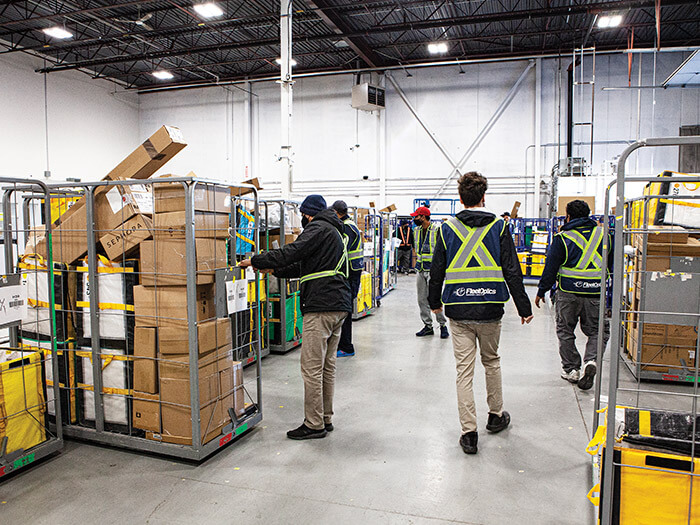 In addition to this Oakville, Ont., sorting facility, FleetOptics also has a 25,000-square-foot facility in Mississauga, Ont. (Photograph by Aaron Wynia)
In addition to this Oakville, Ont., sorting facility, FleetOptics also has a 25,000-square-foot facility in Mississauga, Ont. (Photograph by Aaron Wynia)
FleetOptics was founded in 2015 by John Mann, a veteran of the transport industry, and his friend Vince Buckley, whose family has been in the business for four generations. (Buckley Cartage, their trucking company, dates back to the ’50s). The two met in the ’80s while attending the University of Windsor, and they complement each other nicely: the silver-bearded Buckley is garrulous and outgoing, while Mann is clean-cut and compact, with the reassuring air of a problem-solver. They were already working together at Agile Logistics, a company that helped domestic and international transportation and freight companies streamline their processes. (They remain managing partners of that enterprise as well.) Piggybacking on their experience with Agile Logistics, they originally founded FleetOptics as a B2B solution, ferrying merchandise to retailers from its point of origin.
By 2018, they’d already started working with large retailers, shifting away from B2B and toward consumer deliveries. The turning point, Buckley and Mann say, came that year when Canada Post workers launched a series of rotating strikes that slowed mail deliveries across the country to a glacial pace, just as the holidays were approaching. As millions of Canadians waited for parcels that remained stubbornly stuck, FleetOptics quietly stepped up to help fill the gap.
“We had just enough space at our facility,” Buckley recalls. “We were just packed in. I felt really bad for our sorters. That was the real a-ha moment.” All of a sudden, FleetOptics was on the precipice of a major expansion—business as they knew it was about to explode. “We realized, ‘Oh my God, we’ve got to get a bigger place!’” They quickly upgraded from a 1,500-square-foot unit to a 25,000-square-foot facility in Mississauga, Ont. and doubled down on technology and machinery to bolster efficiency.
It was around then that Mike Kee, a CPA, left his role at Sobeys to join FleetOptics as the company’s director of finance. (His relationship with Buckley goes back to the early aughts, when he’d been a manager of finance and admin at Buckley Cartage.) “Amazon was just starting to come on board and so was business-to-consumer retail—but just in a trickle,” he says. “The key was recognizing the potential for growth in e-commerce, and I think John and Vince could really see it coming. We’re riding that wave now.”
The trick was to build on a relatively old-school industry (logistics—the complex dance of getting things from one place to another) using a relatively new innovation (agile technology that links drivers’ real-time GPS info with back-end systems). And, for that, FleetOptics had a secret weapon: it developed a deceptively simple app that tracks the exact location of every shipment and offers an estimate of when the item will be delivered. Compared to Canada Post’s fuzzy delivery forecasts, the FleetOptics approach can assuage the frustration of consumers wondering exactly where parcels have landed. For retailers, having easy access to package-status data can reduce customer service costs. That technology was based on Mann and Buckley’s experience with “the shortcomings of legacy carriers’ technology.”
Here’s how their business works. Let’s say you need laundry detergent and, happily, manage to find the exact brand you like on Amazon. You click on the button that triggers a Prime two-day delivery. If you’re lucky, that detergent has already travelled on a truck from the manufacturer to its temporary home in a massive Amazon warehouse within driving distance of your home, called a fulfillment centre. The information from your order might trigger a wheeled robot in that warehouse to locate the shelf where the Tide pods are housed and carry the shelf to a worker, who selects the item, scans it and sends it to be packed up for shipping. FleetOptics handles the last bit: its people retrieve your detergent (along with any other Amazon orders headed out for delivery) and bring them to the FleetOptics facility, where shipments are divvied up according to local routes. From there, a driver loads the pods in her van, drives through the city and deposits them on your doormat. Miraculously, the entire process only takes a matter of hours.
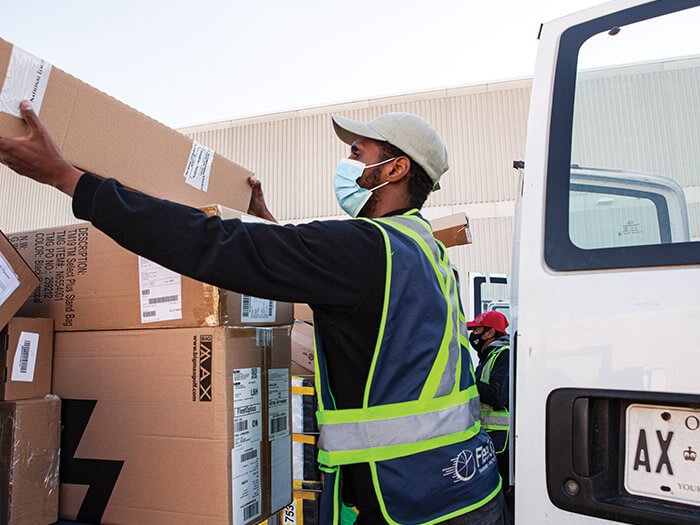 FleetOptics has some 350 drivers who deliver around 50,000 packages a day (Photograph by Aaron Wynia)
FleetOptics has some 350 drivers who deliver around 50,000 packages a day (Photograph by Aaron Wynia)
Online purchases surged during the early days of the pandemic; Mann describes that period as “a blur.” The company mobilized around trying to fulfill next-day delivery commitments, quickly tripling its fleet of drivers from 100 to 350. One example stands out: in Vancouver, during a weather delay, a facility supervisor stepped up to personally ferry packages on Christmas Day so nobody would be left waiting for presents that never arrived. Pandemic-related restrictions, of course, have intensified urgent demands: when your home-schooling kid discovers she desperately needs craft supplies for a virtual class project tomorrow, you need to find a way to get those items into her hands without leaving your house. A recent report from Shopify found that nearly half of global consumers will be shopping online more frequently once the pandemic is over, and that the same-day delivery market will reach nearly $10 billion in 2022.
For FleetOptics, increased consumer demand for speedy deliveries has resulted in tremendous growth. They saw revenues jump from $65,000 in 2015 to $24.2 million in 2019. Thanks to the pandemic, 2020 was a banner year, earning the company $43.5 million. The first two months of 2021 were even more remarkable, with revenues up more than 100 per cent year over year.
Dispatcher Paul Cimoroni witnessed that growth firsthand. He joined the company about three years back, working first as a driver and then as a sorter in the flow-through facility. Back then, he says, he and his colleagues were delivering maybe 500 to 1,000 packages per day—and all of those were sorted by hand. Now, he says, he’s overseeing 10,000 to 20,000 packages per day, which are, happily, batched and routed using well-calibrated computer systems.
As of April 2021, FleetOptics has some 350 drivers who deliver around 50,000 packages a day. “When I first started,” says Cimoroni, “it was myself and a colleague, literally going through skids of packages. We’d pull one marked M6H and put it on a skid and then sort it with other ones in the same postal code. Obviously, you just can’t do that when you have the number of packages we’re going through.” Now, FleetOptics uses its in-house system to scan and organize packages, which are sorted into rolling carts, which in turn are scanned and assigned to particular routes. These days, when Cimoroni arrives at the facility around 5:30 a.m., he assesses the schedule. Typically, they’ll have 80 to 100 routes lined up, each of which corresponds to an individual driver. In the past, all those drivers would likely have showed up at the facility at once; now, they schedule waves of about 25 to 30. As each driver arrives, they receive their route numbers and proceed to correspondingly numbered racks where they collect their packages.
While COVID-19 has been beneficial for large retailers, it presents its own set of logistical challenges. FleetOptics reconfigured its conveyor system, to allow for more space between sorters (who wound up having to work longer hours). It implemented strict protocols around daily temperature checks, masks, face shields and social distancing, and drivers are no longer required to obtain signatures upon delivery, to limit interaction with customers. So far this year, it’s only experienced six cases of COVID-19 in a company of 450 employees.
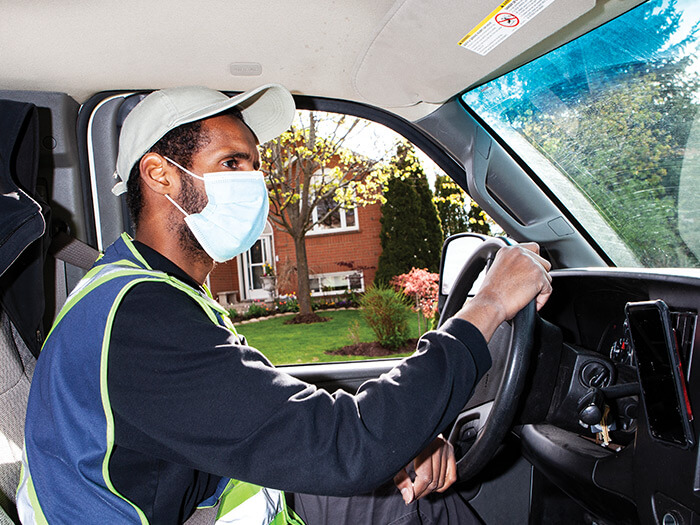 On a typical day FleetOptics will have 80 to 100 routes lined up, each of which corresponds to an individual driver (Photograph by Aaron Wynia)
On a typical day FleetOptics will have 80 to 100 routes lined up, each of which corresponds to an individual driver (Photograph by Aaron Wynia)
Tania Correia, a driver who’s been working for the company since October 2020, is a parent to a school-aged child. She says the company’s flexibility in terms of shifts and other time-sensitive accommodations has been a tremendous perk. Correia wakes up at 4:50 so she can arrive at the sorting facility 15 minutes before her 6 a.m. shift. Once she receives her route number, she finds the numbered cart that holds the packages she’s responsible for transporting, loads up her vehicle, paying Tetris-like attention to how she’s arranging items based on the order in which she plans to deliver them. Then she grabs a tracking device and hits the road. COVID-19 has shifted traffic patterns, she says—which is a boon, since she and her colleagues have more items to deliver than ever before. And it’s changed their relationships with the people receiving their deliveries. “Some people are very afraid of opening the door,” she says. “I get it—I can feel that way, too. I mean, we’re not expecting to get a hug but, unfortunately, it’s sometimes required for them to take the package in hand.” But the positive experiences balance out the negative ones. She’s seen houses where people have left out drinks and snacks as a token of appreciation. “It’s so nice to see those things, even if we don’t actually take them.” And, in some cases, a driver dropping off a package becomes a kind of lifeline to the outside world. “A couple of days ago, I made a delivery to a woman who hadn’t been out of her house at all,” Correia says. “She was like, ‘Oh my god, it’s so nice to see a person!’”
Like a shark, a business must move forward to survive. One of the challenges right now, Kee says, is that business trends are following more of a shark-fin model, rather than a bell curve—that is, rather than a steady climb, followed by a rolling peak and a gentle descent, demand for particular products or ideas are arcing upward and then rapidly plummeting down. “In other words,” he says, “whatever you offer, it’s only got so much of a life.”
That means, more than ever, companies—FleetOptics among them—have less time to anticipate their next move. It means they constantly have to add value to what they’re already doing, to convince new clients to choose them over another final-mile service. This might mean, for example, turning their delivery vans into mobile marketing tools by offering a full billboard-style wrap—as with Sephora, whose beautifully packaged cosmetics arrive at customers’ homes by way of Sephora-branded vehicles.
The company’s tech-savvy approach has thus far led to exponential growth—and not just in revenue. Over the past year, the Mississauga-based operation has expanded into several key markets across the country, setting up flow-through facilities of 22,000-square-feet apiece in Vancouver and Montreal; Mann says they’re poised to open shop in Ottawa and Calgary later in 2021. “There’s not a lot of overhead or fixed costs to doing this,” offers Kee, who, as a CPA, is focused on the bottom line. He says he’s looking at the revenue margin per account per site on a weekly basis. That lean, mean approach helps offset the risk involved in scaling up: the company can easily expand and contract its fleet of contractors to reflect demand.
But being able to sustain that growth, says Kee, also means looking at the other piece of the FleetOptics puzzle—in addition to its core business of delivering packages, the company has also invested time and money into developing software that allows parties on all sides to meticulously track that process. “We need to continue to develop that, to integrate it more with back-office systems,” Kee says. The company might expand the features it offers via the FleetOptics app—could retailers or purchasers someday have the opportunity to watch while a driver makes his way up onto the porch and, via text message, direct him to leave the package in a specific spot in real time? It also might mean doubling down on sustainability, Mann says. “Our goal is to focus on a strategy to continue to reduce our carbon footprint as more electric vehicles become available.” AI will be part of that strategy, he adds. “But I’m not so sure about drones.”
THE RETAIL RESPONSE
Just as e-commerce surged, so too did the sales of all-of-a-sudden hot ticket items. Find out why binoculars became a pandemic must have and how one Canadian e-motorcycle company capitalized off increased sales. And is the Livestream shopping trend the future of e-commerce?